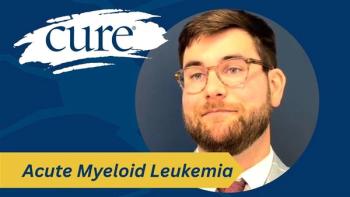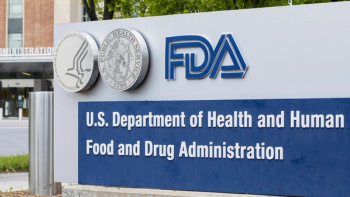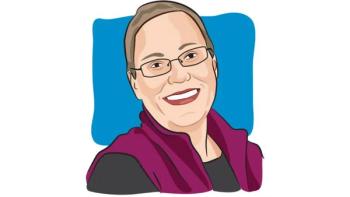
Getting Diagnosed with the 'Big C' During the 'Big C'
A newly-diagnosed patient talks about her experience of being diagnosed with breast cancer amidst the COVID-19 pandemic.
I got a mammogram a couple of months prior to COVID coming through and they called me about a week later and said, “We need you to come back in for a mammogram again. We’re not sure if there’s anything. So, we’ll see.” So, I said, “Sure, but I’m too busy. So I need you to give me some dates/times that are available.” Low and behold, two months later was the first time I could get in.
I got in to see them two months later, but COVID happened in the middle of all of this. So, in all of my travels, I was suddenly home bound. They called to make sure I still wanted to go to the institution to get my mammogram, or if I’d rather go to the breast center. I said, “No, the institution is really small. I’ll just go there.” I kept my original appointment, and I went in to get my subsequent mammogram and an ultrasound to see what they might see. Sure enough, they thought that they needed a biopsy.
I stayed at the hospital and waited until they could squeeze me in for a biopsy. The interesting thing for me is that I’m lying there and they’ve got masks on, I’ve got a mask on, and I’m unsheathed and I don’t have anything covering me. And there was some comfort in having the mask on. There’s something about all women’s exams where you just kind of having to bear everything and it’s a little embarrassing. They try to make small talk, but it’s just really uncomfortable. So, I felt a little protected by laying there with my mask on. I couldn’t really tell their reaction because they had a mask on.
I could tell they were seeing something on the ultrasound: They were measuring it; I saw her putting markers on it to measure the size. So, I knew this was something that I was going to want to follow up on.
They took some biospies. In the middle of all of this, I had gone through a transition of my primary care provider. So, my first physician was someone that when I originally sat in the room, it felt like I was the smartest person in the room. And that made me uncomfortable. So, I was seeking a different primary care provider. Between the first mammogram and the second mammogram, I had found a second primary care provider.
But an hour after I got home from my biopsy, the first primary care provider called me and said, “This is Dr. ‘not the sharpest tool in the shed,’ I just got your report and I’m not happy.” It’s the first time in all of this, getting a potential diagnosis, that my heart jumped into my chest. I thought, “Oh my God, what does he know?” I quickly said to him, “I have transferred primary care providers. I need you to make sure my new one has this information. If you could please share this with him that would be great.” And I got off the phone with him and after that quickly got on the phone and called the nurse who assisted with the biopsy. I said, “What is he talking about, I just got this phone call?” And she said, “You have to be kidding. They haven’t even picked up your sample yet.” And we realized that he was only just now reading something from my mammogram two months prior. So, again, just making me more confident about changing my primary care provider.
It did cause me to seriously think, “What if I get that phone call and someone says they aren’t happy with what they found?” So, mhy biopsy was on Friday and I spent the weekend thinking, “What if?” I’ve been in the oncology space for 30 years. I’ve talked the talk. I work with a lot of different providers and now I get to walk the walk. Everywhere I’ve ever lived, I’ve always thought to myself, “If I had this, I would go see him or her.” And I had not done that since I moved to Connecticut.
So, when this came to be a reality, I just sat back and thought, “Let me take a moment to say if this comes in positive, I need to say what will my game plan be?” So, I thought about it for a. while and came up with a medical oncologist I thought would be reasonable for me to see, collaborative with the surgeon I decided to see, and also knew enough about the community setting and had enough clinical trials at his fingertips in case I needed it. I’ve worked with him a bit in the past and felt comfortable with him. That’s what I did from Friday to Monday, trying to figure out if I needed a game plan, this is what I had.
It gave me a lot of peace and comfort knowing that I could sit back and relax and know that I had a game plan.
Monday, they called saying, “You have invasive ductal carcinoma.” They wanted to send me to a surgeon, and I said, “Let me think about this and I’ll follow up with you.” I immediately placed a phone call in to the surgeon who I wanted to work with that was about an hour away, but I still felt like that was reasonable, someone who is well respected in the space. She immediately made time for me. I shared with her what I knew and told her as things came in we’d be sure to get those things to her. Immediately she got on the phone, got the ball rolling, had nurses calling me, setting up appointments, making sure the medical oncologist I had chosen was going to be in the loop as quickly as possible.
We just started making a game plan on Monday, not knowing a lot of data yet, but making sure I had the confidence knowing I had access. That made me feel better.
On Tuesday, I found out from the nurse navigator from the local surgery center, that I had ER-, PR-positive breast cancer, and the HER2 had not been done yet. So, I made her aware that I already reached out to a surgeon and she could take me off her list. Her concern was that I was not falling through the cracks and that I had a game plan. She quickly figured out that I knew what a KI67 was and the difference between HER2 and ER/PR. I did find out I had vascular invasion. She shared with me that I was histologic grade 1, nuclear grade 1 and that the size was 0.8 by 0.7 by 0.6 centimeters. When I told my surgeon that I thought it was less than 1 centimeter, she said, “We need the specifics because less than and being less than are very different.” So, sure enough, I was less than and she felt better about that at that point moving forward with the game plan.
I found out on Wednesday, from my new primary care provider, that was HER2-negative. He had followed up with me just to check in and make sure that I had a plan. He was going to make an appointment for me with the same surgeon locally, and I ensured him that I had a plan and he felt comfortable with that. He just asked to be kept in the loop.
On Friday of that same week, I went into the medical oncologists’ office to see him at his center, about 30 minutes from my house. The surgeon (video-conferenced) in on my cell phone. We propped her up on the counter and she participated in the exam and consultation. I had both of them in the same space, coming together to talk to me.
The same thing happened to me with my medical oncologist: He had a mask on, his nurse had a mask on and I had a mask on and there was something about going, “Here they are!” and not being as timid or shy or all the body conscious things that women go through. Because of my COVID mask, it was interesting to be able to feel a little bit of protection, anonymity a little bit from having the masking on. And having my surgeon consulting with me on a cell phone looking at my body as well, it was just interesting having that all play out.
We had an excellent conversation there in the office. Interestingly, the cancer center was very quiet and sparse and bare. There were individuals sitting by themselves with one chair available and two chairs covered in blue plastic, and then one chair available and two chairs covered in plastic for social distancing purposes. They took my temperature when I went in before I could even enter the center. So, they were doing all of the things they could to make me feel that they were protecting me and themselves.
Getting a diagnosis during that time, the suggestions the doctors gave me were also very different from what they normally do. They called it the European model, and instead of starting with surgery, they said I can start on chemotherapy if I felt comfortable. Apparently, a lot of women feel the need to get this out quickly. I didn’t feel that way because it wasn’t anything that I felt. The mammogram found it. Also, because I couldn’t feel it, it’s something I was fine with: the possibility of chemo or hormone therapy could shrink it down prior to surgery.
They left a marker in when they did the biopsy, and that marker will be what the surgeon looks for if they can’t find the tumor because it’s shrunk down so small. That’s my hope: that she can’t find anything but the marker.
So, currently I’m taking tamoxifen and I have a consultation set up in June with the surgeon. And we’ll see how that goes.





